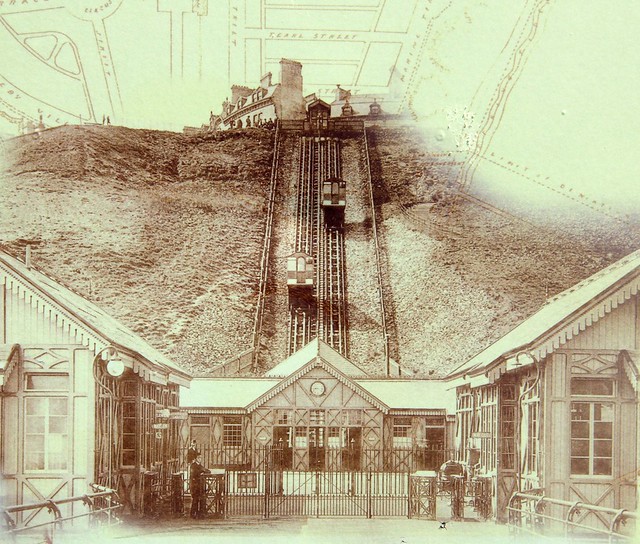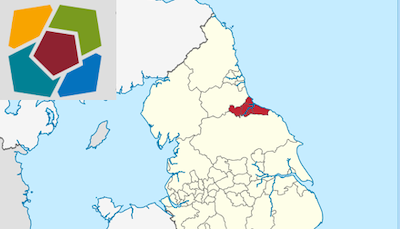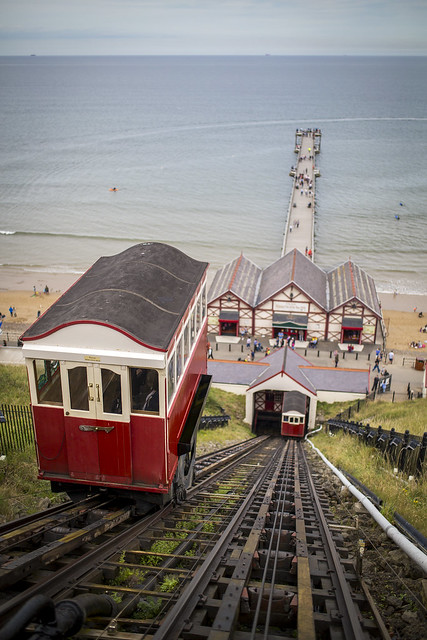Saltburn by the Sea 09-06-2015

-
Description
Saltburn Funicular Railway is the oldest working water-powered inclined tramway in the world. It was built to transport passengers up and down the steep north-facing cliff behind the town's pier. It replaced an 1870 vertical cliff lift on the same spot, and remains in regular use between March and October. The town of Saltburn-by-the-sea is some 37m above its pier, with a steep cliff between the two. The pier's engineer, John Anderson, decided to build a cliff lift to make it easier for people to access the pier. Work began soon after the pier opened in May 1869, and the lift opened on 1st July 1870. The lift was a 36.6m high vertical water-powered hoist housed in a tapering lattice timber tower. A narrow horizontal walkway supported on timber trestles linked it to the cliff top. The lift cage could accommodate 20 people and moved up or down by filling and emptying a water balance tank. The structure was roped to the ground for additional stability. Saltburn Pier Company owned the hoist until August 1883, when it was sold to the Owners of the Middlesbrough Estate consortium. The new owners judged the lift unsafe, apparently it tended to stop halfway and much of the timber had deteriorated, so it was demolished that same year. A new inclined tramway, or funicular railway, opened at the same location (directly in line with the pier) and began taking passengers from 28th June 1884. It was designed by George Croydon Marks (1858-1938), working for Richard Tangye's (1833-1906, knighted 1894) company. The funicular railway has two cabins that run on parallel tracks each 63m long, set at a gradient of 1 in 1.4 (71 percent). Each cabin accommodates up to 12 people and they feature decorative stained glass windows. The cabins are mounted on triangular iron subframes, which keep the floors level as they travel. The subframes house large water tanks. When one cabin is at the top of the cliff, the other is at the foot. The tank in the cabin at the top is filled with water until it exceeds the weight of the cabin below and descends under gravity, raising the lower cabin. When the first cabin reaches the bottom, its tank is emptied and the top cabin’s tank is filled, ready for the process to restart. A nearby spring supplies the necessary water, which is stored in two reservoirs, one of 136,380 litres at the lower station and another of 84,100 litres at the cliff top. It is pumped from the lower to the upper reservoir at a rate of 818 litres per minute. A 4.5kW Otto gas engine, working from the town's gas main, originally powered the pump. An iron winding wheel also controls the movement of the cabins, with double grooves for the running cables (located midway between the rails) and a flange for the brake system. The wheel is operated from a small building at the top of the cliff. During the winter of 1921-2, the track gauge was changed from 1.143m to 1.283m. In 1924, the gas engine was replaced with a direct current generator and an electrically operated water pump. The cabin bodies were replaced in 1955, without stained glass. At the end of the 1974 season, the railway sleepers were renewed. In 1979, new aluminium carriages echoing the original design, complete with stained glass windows were installed. In 1997-8, the tramway was given a comprehensive refit to ensure it complied with modern safety standards. In 1998, the original winding wheel was replaced and a new hydraulic braking system installed. From 19th September 2010 to 11th April 2011, the funicular underwent restoration at a cost of £30,000. The carriages were taken off-site in November 2010 for specialist refurbishment, during which an intercom system was added. Machinery: Tangye Ltd Cabins: Metropolitan Railway Carriage & Wagon Company Ltd Gas Engine: Crossley Brothers Hydraulic Brake System (1998): Skelton Engineering Aluminium Carriages (2011): Stanegate Restorations -
Owner
Karen Roe -
Source
Flickr (Flickr) -
License
What does this mean? Attribution License
-
Further information
Link: https://www.flickr.com/photos/28752865@N08/19753187165/
Resource type: Image
Added by: Simon Cotterill
Last modified: 8 years, 1 month ago
Viewed: 874 times
Picture Taken: 2015-06-09T11:57:46 -
Co-Curate tags











